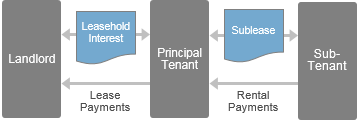A sublease is an arrangement between a rental property’s principal tenant and a subtenant, whereby the lease agreement between the landlord and the tenant remains in force and governs the terms of the sublease. In a multi-dwelling unit, all of the units may be owned by a single landlord with each leased to the resident tenants, as in an apartment complex, or owned separately and leased to a tenant, as in a condominium, who may sublease it to a subtenant.
| Subleasing |
 Source:
|
The principal tenant is the party with whom the landlord has entered into a lease and who has or may sublease the premises and who remains ultimately responsible for the lease. The principal tenant in a sublease is both a tenant and a lessor. The subtenant is the party who rents from a rental property’s principal tenant by either sharing or taking over the rental from the principal tenant. The principal tenant remains solely responsible to the landlord for the rent, which the subtenant is obligated to pay to the principal tenant, and for any damage, including that caused by the subtenant. Most landlords prohibit subleases unless they have given prior written consent.



Leave A Comment
You must be logged in to post a comment.